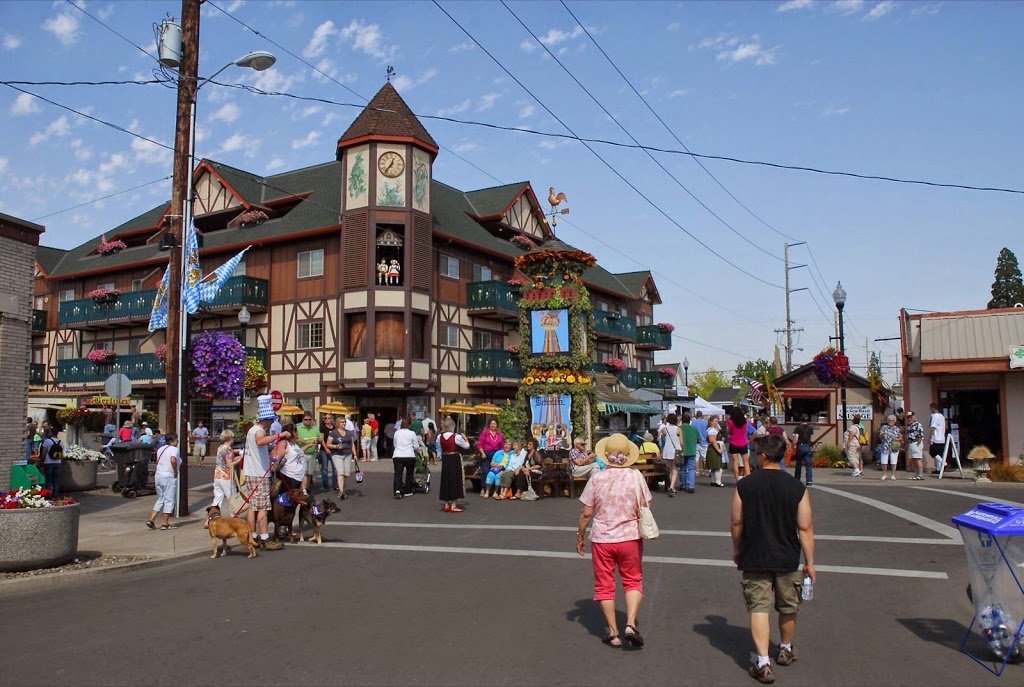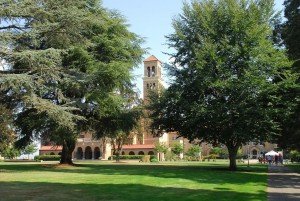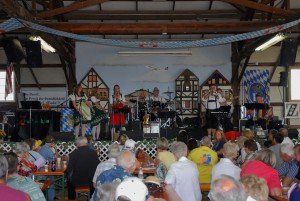 |
| Mount Angel 1961 |
A visit to Mt. Angel can be two different experiences. The city has cultivated a Bavarian atmosphere of community good will and celebration. On the hill above, the Mount Angel Abbey reminds us of the spiritual aspects of our lives.
The 1847-8 pioneers of the area around Mount Angel were primarily of English descent, coming from Virginia, Tennessee, Kentucky and Missouri. Clashes among the native Mololla, Cayuse and Klamath Indians and these settlers were common, culminating in the Battle of the Abiqua in March of 1848. After the battle, many native people migrated south, and more settlers began claiming the fertile land for farming.
Although we associate the city of Mt. Angel with its Swiss-German traditions, it was originally an 1850 town site named Roy by Benjamin Cleaver. Within a few years, the thriving town had a church and school. By 1882 a post office was established with that name. During these first thirty years many German and Swiss Catholic settlers made their homes here on the rich farmland. Their St. Mary’s Church was built in 1880. In the following year, Rev. Fr. Adelheim Odermatt of the Order of Saint Benedict came to America from Engelberg, Switzerland, seeking a location for a monastic community. By that time, a large number of immigrants from the Bavarian section Germany, traditionally Catholic, had settled in this area. Fr. Odelheim selected the nearby highland as the location for an abbey and to serve the several parishes in the area. The community that would later become the abbey officillly as founded in 1882; it was elevated to an abbey in the early 1900s.
Because of this new influence, by 1883 the community became known as Mount Angel (an English reference to Engelberg). The Benedictines were a source of educational opportunities as well, creating the Mount Angel College and Seminary (now known as Mount Angel Seminary), the Mount Angel Academy and the Normal School for Girls. Although fires have destroyed some of the original institutions, many have been rebuilt or renovated. Today, both the town of Mt. Angel and the abbey above it on the hilltop (with a St. Benedict post office), continue to celebrate more than a century of Bavarian culture.
In the past there were several Mt. Angel entries in the Capitol Journal newspaper:
1908: Mt. Angel College offered board, tuition and laundry for $250 a year.
1917: P. Z. of Mt. Angel brooded and worried over a property deal whereby his brother foreclosed on a mortgage on a building and real estate and then sold both for a larger sum than the mortgage called for. So, P. Z. detonated sticks of dynamite under the moving picture theater operated by his brother. The explosion blew a hole in the side of the building and badly shattered the interior.
1926: A short circuit in a truck stored in a garage was believed to have started a fire at Mt. Angel College and the Benedictine monastery. Loss was estimated at $1,000,000 in building, rare manuscripts and equipment.
1927: A gathering of 2,500 people on the summit of Mt. Angel July 16 witnessed the Rt. Rev. Abbott Bernard lay the cornerstone of the new St. Benedict Abbey. This was an initial step by the Benedictine fathers towards rebuilding a monastery, seminary and college destroyed by fire during September 1926.
1928: Rosalina Keber, Capitol Journal’s society editor, interviewed Mrs. Charles Bickner, a recluse living on a seven-acre plot in Butte Creek canyon [6 miles north of Mt. Angel]. Mrs. Bickner had not yet heard a radio or Victrola and had not seen but a single automobile during a trip to Marquam in 1912. Entry into Mrs. Bickner’s cabin revealed a stove without a pipe. Until a stovepipe could be had, she just opened a window when she started a fire and let the smoke blow out.
1940: The Mt. Angel’s basketball team was to play Sioux City’s Colored Ghosts whose members included “Suitcase” Simpson, “Slow Motion” Graves and “String Beans” Potts.
(See “Ben Maxwell’s Salem, Oregon,” edited by Scott McArthur, 2006.)
 |
| Oktoberfest visitors at the Glockenspiel |
When Mt. Angel was incorporated in 1893, it had 25 legal voters. Today, with a size of 1 square mile, it has a population of 3,286. It is about 18 miles NE of Salem on Highway 214, nestled among rolling hills and flat farms producing Christmas trees, berries, pumpkins, hops and grass crops. The city employs 23 full and part-time staff members to provide services to the surrounding community. Mt. Angel owns and operates the water and sewer systems and wastewater treatment facilities, six local parks, a library, the police and departments and an administrative staff that handles day to day calls, billing, court, and various other functions of the City. It has a Council-Manager form of local government with four Commissions (Planning, Park Tree, Library and Budget) and publishes a City Newsletter. Mt. Angel’s economy is supported by Wilco, Providence Benedictine Nursing Center, Mt. Angel Towers, Highland Laboratories, and the Mt. Angel School District.
The town itself has a lively Old World flavor with Bavarian storefronts and a large community church. It is home to one of Oregon’s most successful festivals, the Oktoberfest, attracting 350,000 people and includes beer and wine gardens, softball tournaments at Ebner Ball Park, a local football game and volleyball invitational tournament, carnival rides, crafts, a wide assortment of German food, and a two day car show.
February ~ Wurstfest
Sites to visit include three National Register sites:
Windischar’s General Blacksmith Shop (1902), 110 Sheridan Street
Glockenspiel ~ (2006) tallest in US at 49 feet: view at 11am, 1pm, 4pm and 7pm.
Saalfeld House Museum
Elaine Annen Doll Museum, located in the new Festhalle Building, is open two Fridays and two Saturdays each month.
Saalfeld Family Park, at College and Garfield Street, opened on Friday, August 31, 2012
 |
| Mount Angel Abbey Church |
at explains the library’s history and its services.
A more re When you are in Mt. Angel, drive up the wooded road to the abbey, where the welcome is “All guests are to be received as Christ.” The Kalapuya called the butte upon which the abbey sits Tapalamaho, which means “mount of communion.”
The Benedictine community that became the abbey suffered two major fires in its early history. On fire in 1892 destroyed the monastery, church and seminary buildings. Funds were raised and buildings rebuilt but another fire in 1926 consumed the new monastery. Again the monks rebuilt, completing the first section of the existing abbey in 1928. More structures followed, including Aquinas Hall and a gymnasium. A library, designed by Finnish architect Alvar Aalto, was dedicated in 1970s. Today, library guests are welcomed with a guide booklet thcent addition to the abbey is a bell tower, which was placed in the abbey’s church in 2007 and contains eight bells, one of which is described as the largest swinging bell in the Pacific Northwest. Visitors to the abbey’s church can enjoy informal sacred music recitals as they take a restful pause in their activities.
The abbey’s website, www.mountangelabbey.org, offers more information, describing its museum as “an eccentric collection of artifacts.” When you are at the abbey, ask for a self-guided walking tour booklet. It also gives the bell schedule for monastic prayers in the church
Listing Mt. Angel attractions is useful, but cannot fully express the tremendous effort the residents have made to create not only a lively tourist destination, but a pleasant small town in which to make their homes. The next time you visit, enjoy the celebration, but drive a few blocks into the residential neighborhoods and see the real Mt. Angel community.
Each Tuesday, after a city was featured in that Sunday’s Statesman Journal, KMUZ broadcasted “Marion County 20”. To learn more about Mt. Angel, listen to the podcast listed on the KMUZ archives.


One Comment